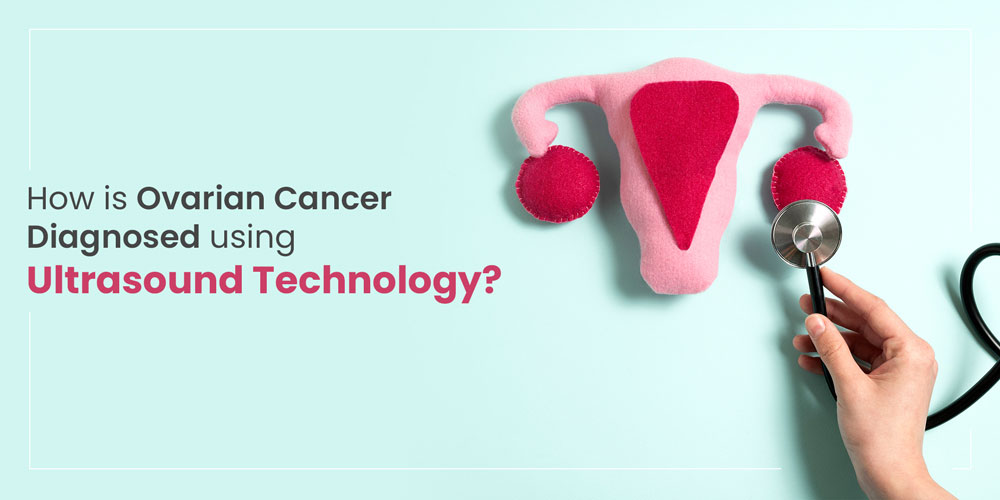Ovarian Cancer starts when cells in the ovaries begin growing and reproducing abnormally. This rapid and uncontrolled division of cells leads to the formation of tumours in the body.
While it is often challenging to detect Ovarian Cancer in its early stages, doctors use a combination of approaches to diagnose it, like pelvic tests, Imaging tests through Ultrasound, Blood tests, Biopsy and CT scans.
How does Ultrasound Detect Ovarian Cancer?
In Ultrasound technology, high-frequency sound waves create an image of the internal organs.
Ultrasound for ovarian cancer is done with a probe which is placed on the abdomen of the patient or, in some cases, is inserted into the vagina to transmit sound waves and detect the echoes as they reflect off organs. These echoes are then converted by a computer into an image on the screen, enabling the doctor to visualize the size, form, and internal structure of the ovaries.
What Can Ultrasound Detect in the Ovaries?
Ultrasound can detect possible abnormalities that may require further attention, such as
- Size/form: Whether the ovaries’ size and form have changed in any way.
- Ovarian cysts: Often detected on ultrasounds, cysts are sacs packed with fluid. While most cysts are not cancerous, some can be.
- Solid Masses: These are less common than cysts and thus raise more concern for cancer. However, not all solid masses are cancerous.
- Changes in Tissue Density: Ultrasound can also show us the internal structure of ovaries so that abnormal densities might indicate potential problems.
Further Tests That you need after an Ultrasound
Ultrasound alone is not enough to detect ovarian cancer. If any other abnormality like a cyst or solid mass is discovered on ultrasound, you might go for a biopsy and continuous monitoring.
Biopsy
If an ultrasound reveals a suspicious mass in your ovary, doctors go for further processes to examine if it is cancerous or not. A biopsy helps obtain a closer picture of the cells to be specific.
For a biopsy, a sample of tissue or cells is taken from your body so that it may be sent for further investigation in a laboratory. Biopsy helps in finding out if you have cancer or another illness.
Ovarian Cancer Can Be Biopsied in Several Methods.
- Surgery: This is the most well-known method, specifically if the mass needs to be removed.
- Needle biopsy: A tiny needle may occasionally be used to obtain a sample through your skin under the guidance of an ultrasound or CT scan. When surgery is not an option, this is done.
- Fluid sample: If you have an accumulation of fluid in your abdomen, a sample of that fluid can be examined for cancerous cells as well.
CT Scan for Ovarian Cancer
CT Scan is an X-ray test that provides you with a precise cross-sectional image of the body. The test helps the doctors in diagnosing the spread of the tumour.
A CT scan can identify larger ovarian tumours and whether they expand into surrounding structures. It can also detect enlarged lymph nodes, liver or other organ malignancy, and ovarian tumours impacting the kidneys or bladder.
Frequently Asked Questions
1. Can ovarian cancer be seen on an ultrasound?
While ovarian cancer cannot be conclusively diagnosed with ultrasound, it can identify abnormal tumours in the ovaries. A biopsy is required to be sure.
2. What confirms ovarian cancer?
Only a biopsy can provide definite confirmation of ovarian cancer. This entails removing a sample of tissue from the suspected tumour with a needle guided by an ultrasound or CT scan or by surgery. A pathologist then uses a microscope to analyze the tissue sample to check for cancer cells’ presence.
3. What is the best way to test for ovarian cancer?
There is no single “best” test for ovarian cancer. For diagnosis, doctors usually use a combination of approaches, including pelvic exams, imaging, blood tests and biopsy.
Every woman should go for testing for Ovarian Cancer every 6 months. It is a disease if left undiagnosed can becomes life threatening illness.

